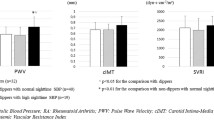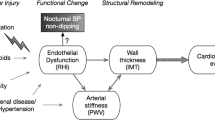Abstract
Objective
Rheumatoid arthritis (RA) is a systemic autoimmune inflammatory disorder which further doubles the risk of developing cardiovascular disease. Some studies suggest that in RA patients, the prevalence of hypertension increases due to prednisolone use, clinical status, genetic factors, and physical inactivity. On the other hand, dipper and non-dipper status in RA patients compared to non-RA subjects has not been investigated to our knowledge. Purpose of the study is to investigate whether non-dipper status is more deteriorated in RA patients.
Methods
Sixty-five RA patients and 61 age-sex-matched control patients were evaluated in this cross-sectional study. Patients were classified according to 24-h ambulatory blood pressure monitoring results. Patients with previous hypertension diagnosis, coronary artery disease, and abnormal kidney function were excluded.
Results
Mean age of the study sample was 53.7 ± 12.3 years and 40.5% were male. There was no significant difference between groups in terms of basic demographic characteristics. Leukocyte counts (p = 0.001), neutrophil counts (p = 0.001), and red cell distribution width (p = 0.000) were significantly higher in the RA group. ABPM results indicate no significant difference between RA patients and the control group in terms of daytime systolic and diastolic blood pressure, nighttime systolic and diastolic blood pressure, and average systolic and diastolic blood pressure results (p > 0.05). There was no statistical difference regarding the non-dipper status of patient groups (p = 0.412). Nocturnal blood pressure dipping was significantly similar between groups (p = 0.980).
Conclusion
In conclusion, RA patients have similar values in terms of nocturnal blood pressure dipping and hypertension diagnosis as compared to normal population.
Zusammenfassung
Ziel
Die rheumatoide Arthritis (RA) ist eine systemische entzündliche Autoimmunerkrankung, durch welche sich überdies das Risiko einer Herz-Kreislauf-Krankheit verdoppelt. In einigen Studien finden sich Hinweise, dass bei RA-Patienten die Prävalenz der Hypertonie aufgrund von Prednisolontherapie, klinischem Zustand, genetischen Faktoren und körperlicher Inaktivität zunimmt. Andererseits ist der Blutdruckabfall bei RA-Patienten im Vergleich zu Probanden ohne RA nach Wissen der Autoren bisher nicht untersucht worden. Ziel der Studie war es zu untersuchen, ob bei RA-Patienten der Zustand ohne Blutdruckabfall schlechter ist.
Methoden
In der vorliegenden Querschnittstudie wurden 65 RA-Patienten und 61 in Alter und Geschlecht entsprechend ausgewählte Kontrollen untersucht. Die Patienten wurden nach den Ergebnissen ihrer ambulanten 24-h-Blutdruckmessung eingeteilt. Dabei wurden Patienten mit vorangehender Diagnose einer Hypertonie, koronaren Herzkrankheit oder mit auffälliger Nierenfunktion aus der Studie ausgeschlossen.
Ergebnisse
Das Durchschnittsalter der Stichprobe betrug 53,7 ± 12,3 Jahre, 40,5% der Teilnehmer waren männlich. Es bestand kein signifikanter Unterschied zwischen den Gruppen in Bezug auf grundlegende demographische Merkmale; Leukozytenzahl (p = 0,001), Neutrophilenzahl (p = 0,001) und Erythrozytenverteilungsbreite (p = 0,000) waren jedoch in der RA-Gruppe signifikant höher. Die Ergebnisse der ambulanten Blutdruckmessung zeigten keinen signifikanten Unterschied zwischen RA-Patienten und der Kontrollgruppe hinsichtlich des systolischen und diastolischen Blutdrucks am Tag und in der Nacht sowie den durchschnittlichen Ergebnissen für den systolischen und diastolischen Blutdruck (p > 0,05). Es gab keinen statistischen Unterschied beim Zustand ohne Blutdruckabfall zwischen den Patientengruppen (p = 0,412). Der nächtliche Blutdruckabfall war bei den Gruppen in signifikanter Weise ähnlich (p = 0,980).
Schlussfolgerung
RA-Patienten weisen ähnliche Werte wie die Normalbevölkerung auf in Bezug auf nächtlichen Blutdruckabfall und die Diagnose einer Hypertonie.
Similar content being viewed by others
References
Gabriel SE (2001) The epidemiology of rheumatoid arthritis. Rheum Dis Clin North Am 27:269–281
Turesson C, Jacobsson LT, Matteson EL (2008) Cardiovascular co-morbidity in rheumatic diseases. Vasc Health Risk Manag 4:605–614
Wolfe F, Mitchell DM, Sibley JT, Fries JF, Bloch DA, Williams CA et al (1994) The mortality of rheumatoid arthritis. Arthritis Rheum 37:481–494
Solomon DH, Karlson EW, Rimm EB, Cannuscio CC, Mandl LA, Manson JE et al (2003) Cardiovascular morbidity and mortality in women diagnosed with rheumatoid arthritis. Circulation 107:1303–1307
Aviña-Zubieta JA, Choi HK, Sadatsafavi M, Etminan M, Esdaile JM, Lacaille D (2008) Risk of cardiovascular mortality in patients with rheumatoid arthritis: a meta-analysis of observational studies. Arthritis Rheum 59:1690–1697
Yusuf S, Hawken S, Ounpuu S, Dans T, Avezum A, Lanas F et al (2004) Effect of potentially modifiable risk factors associated with myocardial infarction in 52 countries (the INTERHEART Study): case-control study. Lancet 364:937–952
Panoulas VF, Douglas KM, Milionis HJ, Stavropoulos-Kalinglou A, Nightingale P, Kita MD et al (2007) Prevalence and associations of hypertension and its control in patients with rheumatoid arthritis. Rheumatology (Oxford) 46:1477–1482
Chung CP, Giles JT, Petri M, Szklo M, Post W, Blumenthal RS et al (2012) Prevalence of traditional modifiable cardiovascular risk factors in patients with rheumatoid arthritis: comparison with control subjects from the multi-ethnic study of atherosclerosis. Semin Arthritis Rheum 41:535–544
Klarenbeek NB, van der Kooij SM, Huizinga TJ, Goekoop-Ruiterman YP, Hulsmans HM, van Krugten MV et al (2010) Blood pressure changes in patients with recent-onset rheumatoid arthritis treated with four different treatment strategies: a post hoc analysis from the BeSt trial. Ann Rheum Dis 69:1342–1345
Metsios GS, Stavropoulos-Kalinoglou A, Panoulas VF, Wilson M, Nevill AM, Koutedakis Y et al (2009) Association of physical inactivity with increased cardiovascular risk in patients with rheumatoid arthritis. Eur J Cardiovasc Prev Rehabil 16:188–194
Panoulas VF, Douglas KM, Smith JP, Taffé P, Stavropoulos-Kalinoglou A, Toms TE et al (2008) Polymorphisms of the endothelin-1 gene associate with hypertension in patients with rheumatoid arthritis. Endothelium 15:203–212
Panoulas VF, Douglas KM, Smith JP, Metsios GS, Elisaf MS, Nightingale P et al (2009) Galectin-2 (LGALS2) 3279 C/T polymorphism may be independently associated with diastolic blood pressure in patients with rheumatoid arthritis. Clin Exp Hypertens 31:93–104
Stamatelopoulos KS, Kitas GD, Papamichael CM, Chryssohoou E, Kyrkou K, Georgiopoulos G et al (2009) Atherosclerosis in rheumatoid arthritis versus diabetes: a comparative study. Arterioscler Thromb Vasc Biol 29:1702–1708
Kitas GD, Gabriel SE (2011) Cardiovascular disease in rheumatoid arthritis: state of the art and future perspectives. Ann Rheum Dis 70:8–14
Mancia G, Parati G (2000) Ambulatory blood pressure monitoring and organ damage. Hypertension 36:894–900
Salles GF, Reboldi G, Fagard RH, Cardoso CR, Pierdomenico SD, Verdecchia P et al (2016) Prognostic effect of the nocturnal blood pressure fall in hypertensive patients: the ambulatory blood pressure collaboration in patients with hypertension (ABC-H) meta-analysis. Hypertension 67:693–700
Aletaha D, Neogi T, Silman AJ, Funovits J, Felson DT, Bingham 3rd CO et al (2010) 2010 Rheumatoid arthritis classification criteria: an American College of Rheumatology/European League Against Rheumatism collaborative initiative. Arthritis Rheum 62:2569–2581
Grassi G, Seravalle G, Quarti-Trevano F, Dell’Oro R, Bombelli M, Cuspidi C et al (2008) Adrenergic, metabolic, and reflex abnormalities in reverse and extreme dipper hypertensives. Hypertension 52:925–931
Castelpoggi CH, Pereira VS, Fiszman R, Cardoso CR, Muxfeldt ES, Salles GF (2009) A blunted decrease in nocturnal blood pressure is independently associated with increased aortic stiffness in patients with resistant hypertension. Hypertens Res 32:591–596
Känel R, Jain S, Mills PJ, Nelesen RA, Adler KA, Hong S et al (2004) Relation of nocturnal blood pressure dipping to cellular adhesion, inflammation and hemostasis. J Hypertens 22:2087–2093
Fontes-Guerra PC, Cardoso CR, Muxfeldt ES, Salles GF (2015) Nitroglycerin-mediated, but not flow-mediated vasodilation, is associated with blunted nocturnal blood pressure fall in patients with resistant hypertension. J Hypertens 33:1666–1675
Hamamoto K, Yamada S, Yasumoto M, Yoda M, Yoda K, Tsuda A et al (2016) Association of nocturnal hypertension with disease activity in rheumatoid arthritis. Am J Hypertens 29:340–347
Karakulak UN, Sahiner L, Maharjan N, Okutucu S, Evranos B, Aladag E et al (2015) Evaluation of the ambulatory arterial stiffness index in patients with rheumatoid arthritis. Blood Press Monit 20:254–259
Tecer D, Sezgin M, Kanık A, İncel NA, Çimen ÖB, Biçer A et al (2016) Can mean platelet volume and red blood cell distribution width show disease activity in rheumatoid arthritis? Biomark Med 10:967–974
Author information
Authors and Affiliations
Corresponding author
Ethics declarations
Conflict of interest
O. Turgay Yildirim, E. Gonullu, F. Aydin, E. Aksit, A. Huseyinoglu Aydin, and E. Dagtekin declare that they have no competing interests.
All procedures performed in studies involving human participants were in accordance with the ethical standards of the institutional and/or national research committee and with the 1964 Helsinki declaration and its later amendments or comparable ethical standards. Informed consent was obtained from all individual participants included in the study.
Additional information
Redaktion
U. Müller-Ladner, Bad Nauheim
U. Lange, Bad Nauheim
Rights and permissions
About this article
Cite this article
Turgay Yildirim, O., Gonullu, E., Aydin, F. et al. Nocturnal blood pressure dipping is similar in rheumatoid arthritis patients as compared to a normal population. Z Rheumatol 78, 190–194 (2019). https://doi.org/10.1007/s00393-018-0451-4
Published:
Issue Date:
DOI: https://doi.org/10.1007/s00393-018-0451-4
Keywords
- Rheumatoid arthritis
- Hypertension
- Nocturnal fall in blood pressure
- Nocturnal hypertension
- Ambulatory blood pressure monitoring




